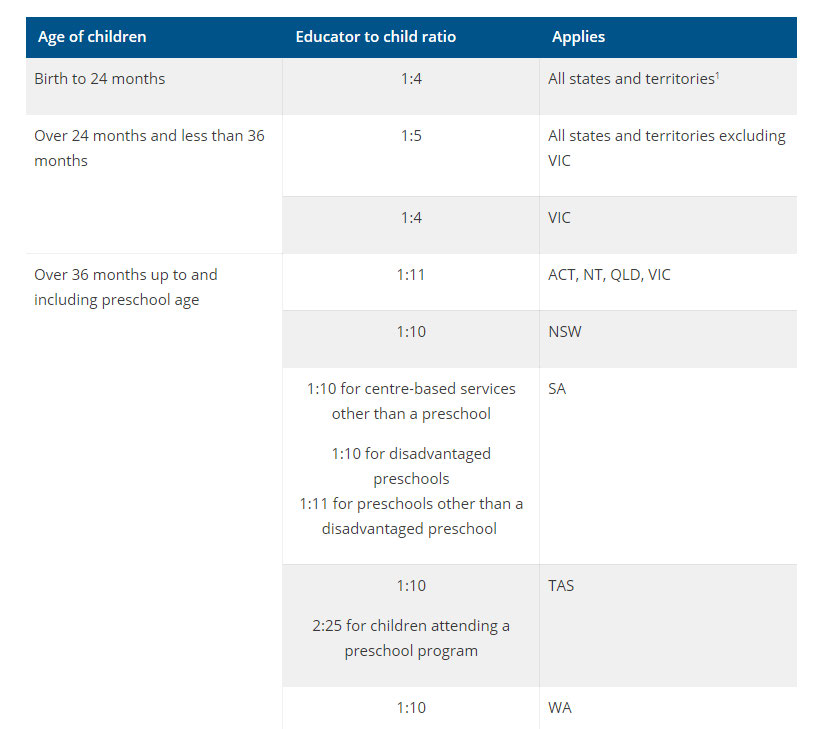 DOCUMENT 1
DOCUMENT 1
FOI 24/25-0145
Research Request – Standard care or supervision requirements for
a child
One standard piece of literature or article that outlines the care/supervision
requirements for a 2 year old and 3.5 year old (24 hours/7 days per week).
Brief
Prefer to be Australian based, taking into account available outside of home
care services (i.e. child care).
To support and AAT case.
Date
20/09/19
Requester
s47F - personal p
Researcher
s47F - personal p
Contents
Leaving children unsupervised................................................................................................................ 2
Leaving children home alone .................................................................................................................. 2
Parental Responsibility ........................................................................................................................... 2
Consultation with ECEI Team .................................................................................................................. 2
Legal cases .............................................................................................................................................. 3
Respite .................................................................................................................................................... 3
Childcare educator to child ratios ........................................................................................................... 3
P a g e |
1
Page 1 of 4

FOI 24/25-0145
Lack of legislation and guidance
There is no Australian legislation outlining what typical parental supervision or care of children looks
like in practice. Legislation is framed in the context of when there is an unsuitable ‘lack of parental
supervision’ or negligence.
To identify what typical care/supervision responsibilities are for parent of a toddler of various ages,
parental and carer responsibility under law in comparable situations have been used e.g. childcare.
Consultation with NDIA ECEI Team
The Early Childhood Early Intervention team were contacted to check if the agency had any
established research on the standard care or supervision hours or parental expectations for children.
The team do not have this research information, but are able to provide individualised guidance in
relation to parent and informal supports for ECEI plans. This highlights that appropriate
care/supervision will be subjective to the circumstances of each case.
Leaving children unsupervised
There is no Australian legislation outlining when it is safe or suitable to leave toddlers or children
unsupervised when playing.
Leaving children home alone
The raising children website, which is supported by DSS, states that there is no one law in Australia
that says at what age you can or can’t leave your child home alone.
In Queensland if you leave a child under 12 years of age for an ‘unreasonable time’ without
supervision you have committed a misdemeanour. However, the legislation also says that whether
the time is unreasonable depends on all the relevant circumstances. Elsewhere in Australia, the law
says you’re legally obliged to make sure that your child is properly looked after. You’re expected to
provide food, clothing, a place to live, safety and supervision1.
However, the website states that it may be suitable to leave a child at home alone if they are
between 9-15 years. This suitability is based on family circumstances and the maturity of the child.
For toddlers 1-3 years, the website also says that child safety at home is
about supervising your
child, creating a safe environment, and teaching your child about what’s safe and what’s not. But
even when you think you’ve removed all the home safety hazards, the reality is that children can still
have tumbles and falls. That’s why
supervision is one of the keys to child safety at home2.
Parental Responsibility
The Family Law Act 1975 (61B) states that parental responsibility, in relation to a child, means all the
duties, powers, responsibilities and authority which, by law, parents have in relation to children3.
The Act does not delineate what parental responsibility is any further than this.
1 Raising Children Website, Leaving children home alone, https://raisingchildren.net.au/school-
age/safety/home-pets/home-alone
2 Raising Children Website, Child Safety at Home, https://raisingchildren.net.au/toddlers/safety/home-
pets/home-safety
3
Family Law Act 1975, http://www8.austlii.edu.au/cgi-bin/viewdb/au/legis/cth/consol act/fla1975114/
P a g e |
2
Page 2 of 4

FOI 24/25-0145
Legal cases
Slater and Gordon list the following legal case studies relating to parents leaving children at home
without suitable supervision:
• A Toowoomba mother was sentenced to six months jail last year for leaving her seven and
eight year old sons locked inside their home for more than 90 minutes while out with her
partner and their other three children. The Magistrate said the incident was very, very
serious and warned of the potential tragedies that could have occurred.
• In 2014, a Mount Isa mother pleaded guilty to leaving her four year old son unattended at
home while she went to the corner store. She told the court that she was gone for no longer
than 5 minutes and left her son at home as he was unwell. She was put on a good behaviour
bond for nine months4.
This is noting that QLD’s position on leaving children home alone is much stricter and enforced to a
higher degree.
Respite
There are STA and respite services in NSW (and most other states and territories) to support families
and carers of people with disability but it is usually for people 6 years>5.
Childcare educator to child ratios
There is limited legislation outlining parental responsibility. However, there is comprehensive
legislation outlining the care and supervision of children in childcare scenarios.
The Department of Education and Training (Victoria) website states that “Children of different ages
and abilities will need different levels of supervision. Younger children will always need to be in sight
of an adult whereas older children may not. In general, the younger children are, the more they may
need an adult to be physically present and close by to support and help them”6.
The National Quality Framework (NQF) sets out the minimum qualification and educator to child
ratio requirements for children’s education and care services7. For centre based care the following
ratios apply. As you can see 1 adult educator is permitted to supervise 4 children under 2 years.
4 Slater Gordon, https://www.slatergordon.com.au/blog/is-it-illegal-to-leave-your-children-alone-at-home
5 Life Without Barriers, Short Term Accommodation & Assistance (Respite) in NSW,
http://disabilityservices.lwb.org.au/where-we-offer-disability-support/nsw-and-act/respite/
6 Department of Education and Training, Supervision, September 2012,
https://www.education.vic.gov.au/Documents/childhood/providers/regulation/pracnotessuperv.pdf
7 Australian Children’s Education and Care Quality Authority, National Quality Framework, 2012,
https://www.acecqa.gov.au/nqf/educator-to-child-ratios
P a g e |
3
Page 3 of 4


FOI 24/25-0145
P a g e |
4
Page 4 of 4




